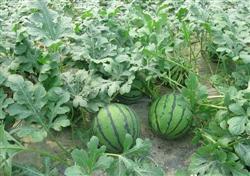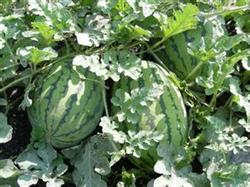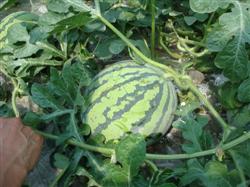High-yield cultivation techniques of watermelon in spring

1. Select improved varieties with disease resistance, high yield and high quality: Zhongda fruit watermelon can choose Xinong 8, Japanese Jubao King, Qingbao King, Heiguan, Gannong 8, small watermelon can choose Heimiren small watermelon, seedless watermelon Heimi No. 1 and No. 2. 2. Select a good planting site: it is appropriate to choose light loam or medium loam with certain slope, convenient drainage and irrigation, deep soil layer and rich organic matter. Watermelon is a taboo crop, which requires that watermelon crops have not been planted in paddy field for 3 years and dry land for more than 5 years. 3. Sowing at the right time to cultivate strong seedlings: watermelons are planted in early spring with double-film mulched fields, and the sowing date can be in the middle of January. at the same time, the seedlings are raised in a hotbed or nutrition bowl plus a small arch shed, and a plastic nutrition bowl of 8 × 10cm can be used in the nutrition bowl. 4. Fine soil preparation and adequate application of basic fertilizer: the soil is deeply turned and whitened for half a month, and the mu is sprinkled with 50-75 kg of quicklime, and then crushed soil is made into a 2.5 m ditch with a height of 40cm on one side and an inclined border of 20cm on the other. A planting ditch with a depth of 25cm and a width of 40cm was dug on one side of the high border. 1000-1500 kg of rotten farm manure, 25 kg of ternary compound fertilizer, 1.5 kg of borax and 4 kg of magnesium sulfate were applied in the ditch. The fertilizer and backfilled soil should be mixed evenly. 5. Planting: watermelon seedlings can be transplanted when they have 3-4 leaves. The planting density per mu is 400-500 for large watermelons and 600-700 for small watermelons. The diameter of planting holes is 10~15cm and the planting hole is deep 10cm. 6. Double film covering: plastic film plus arch film, 100 ml butachlor EC plus 60 kg water per mu before covering the film is sprayed comprehensively, when covering the film, it should be tightly connected and pressed all around, dig the "+" shape mouth on the plastic film of the planting hole, move the seedling in, fix it with soil, pour the root water, then seal the film mouth with soil, finally insert the arch frame, cover with the arch film. 7. Field management: ① fertilizer and water management: the principle of topdressing is careful application of seedling fertilizer, skillful application of vine fertilizer, and heavy application of expanded melon fertilizer. The seedling raising fertilizer is carried out 5-7 days after planting, and it is usually applied once with 0.3% solution mixed with urea and compound fertilizer at 1:2. The vine extension fertilizer is usually about 20 days after seedling lifting, with 10 grams of urea and 15 grams of potash fertilizer per plant. Deep 25cm ditches are opened on both sides of the 35cm outside the fixed planting point, and the fertilizer is applied to cover the soil in the ditch. The application of expanded melon fertilizer was carried out when the young fruit was the size of egg, and each plant was treated with urea 30g 40g, excess calcium 15g, potassium fertilizer 30g 40g. At the 50cm outside the planting point, the application method was the same as that of vine fertilizer, but the position of the ditch should be perpendicular to the extension furrow. Water management: spring planting watermelons must timely do a good job of drainage after rain, so that the rain stops the ditch to dry. In case of high temperature and drought during the fruit setting period, furrow irrigation can be adopted at night, but the border must be kept slightly dry, that is, drainage. ② weeding and soil cultivation: weeding and soil cultivation should be carried out when the watermelon vine grows 40~50cm. If the vine is too long and middle ploughing, it is not only inconvenient to operate, but also easy to damage the vine leaves and cause disease and invade, and hoe the loose soil, which is easy to splash leaves, flowers and young melons after rain. ③ pruning and tending: the vine and pruning should be carried out after drying in dew on the sunny day; the vine should be led to the lower side of the border, and the vine should not be turned or twisted at will; the pruning should take the way of double-vine pruning, that is, in addition to the main vine, a sturdy side vine should be left at the base, and the lower density one should be pruned with three vines. ④ artificial pollination: spring planting watermelon is prone to continuous overcast and rainy weather, affecting insect activities, artificial pollination can be adopted to improve fruit setting rate. 8. Pest control: comprehensive control measures should be taken in watermelon pest control. ⑴ soil and seed disinfection: the cultivated land must carry out flood-drought rotation, the rotation period is more than 3 years, 40% pentachloronitrobenzene 2kg / mu can be used for soil disinfection, 50 kg of poisonous soil can be used for soil disinfection, and 0.1% pentachloronitrobenzene solution can be applied to the whole field or hole irrigation; seed disinfection shall be soaked in 50 ℃ warm water for 20 minutes, then soaked in cold water for 8 minutes for 12 hours, and then germinated or soaked in 25% metalaxyl 800 times for 30 minutes and then soaked in clean water for 8 minutes for 12 hours. ⑵ cultivation of disease-free strong seedlings: strengthen the field management at seedling stage, improve plant disease resistance, seedling stage with 80% metalaxyl 800 times spray control of sudden fall disease. ⑶ cleans the countryside and keeps the countryside clean. ⑷ popularizes the cultivation method of deep furrow and high border. ⑸ advocates the use of organic fertilizer, no longer partial application of nitrogen fertilizer, more application of phosphorus and potassium fertilizer. ⑹ chemical control: ① blight, downy mildew: 50% carbendazim 800 times or 75% chlorothalonil 800 times or 25% metalaxyl 500 times, spray again every 7 days for 2 or 3 times in a row. ② anthracnose: the main diseases are sprayed with 50% carbendazim 500x or 75% chlorothalonil 700x or 80% anthrax Fumei 800x spray every 5 days for 2 or 3 times in a row. ③ white silk disease: 50% carbendazim 500x or 20% chloronitrobenzene 1200 times or 50% pentachloronitrobenzene 1000 times spray ④ blight: available 75% chlorothalonil 600x or 50% topiramate 800x spray. ⑤ Fusarium wilt: select disease-resistant varieties, flood and drought rotation, seed disinfection, potassium permanganate 1000 times solution in the evening spray, 50% carbendazim 500 times solution irrigation root, 20% triadimefon 1500 times irrigation root, the best way to control Fusarium wilt is to use pumpkin and bottle gourd as rootstocks to graft. ⑥ virus disease: the virus type is mainly tobacco mosaic virus, cucumber mosaic virus, seed disinfection, 20% virus A500 times liquid spray, Yunda 120, brassin has the best control effect on virus disease, spraying 4-5 leaves at seedling stage. ⑦ aphids: the occurrence of Bemisia Tabaci is generally severely punished with great heroes and imidacloprid. ⑧: Liriomyza huidobrensis was controlled with 5000-fold solution of Zongmike and avermectin. ⑨ Huang Shougua: topiramate 800x spray. ⑩ melon fruit fly: enemy kills 2000 times liquid, Aifuding 5000 times spray. 9. Harvest: the mature mining can be put on the market 30-35 days after pollination.
- Prev

High-yield cultivation techniques of watermelon in spring
1. Select improved varieties with disease resistance, high yield and high quality: Zhongda fruit watermelon can choose Xinong 8, Japanese Jubao King, Qingbao King, Heiguan, Gannong 8, small watermelon can choose Heimiren small watermelon, seedless watermelon Heimi No. 1 and No. 2. 2, choose a good planting site: it is appropriate to choose a certain slope, convenient drainage and irrigation.
- Next

How to achieve high yield of watermelon in open field in spring
At present, it is the season of sowing and raising seedlings of watermelon in open field. in order to do a good job in watermelon planting and improve farmers' income, the key points of cultivation techniques of open field watermelon in spring are introduced as follows: first, varieties should be selected according to market demand. Select varieties with good quality, high yield and strong disease resistance, such as Qinghong.
Related
- Moge, come on! The staff of the peasant association in the producing area of cantaloupe were frightened when the crowd gathered.
- Causes and Solutions of low Fruit setting rate of Apple
- Symptoms and control measures of passion fruit virus disease
- Fruit growing lesson: how do apple orchards keep high yields?
- Can you build orchards in the mountains? What are the pros and cons?
- How to manage the coloring period of Crisson grape?
- This paper introduces the processing technology of two kinds of fig products.
- How much is a month for retired teachers in rural areas by 2020?
- How can strawberry planting increase sugar content? We should pay attention to management in many aspects.
- What are the cultivation techniques on how to improve the yield of golden fruit?

